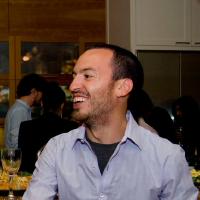00:00:12.160
Thank you so much for having me here! I can't believe how many people are in this room. When I came in, I thought it wasn't going to be full, but you all showed up, and this is really awesome. Thank you so much for coming to hear me speak. I hope to have some exciting surprises for you. Atlanta has been super fun. I'm visiting from New York City, which is a bit chilly compared to this warm weather.
00:00:44.079
Everyone here has been so friendly. For instance, yesterday, I was in an elevator, and a man looked at me and asked how my afternoon was going. I initially thought, 'This man is going to kidnap me, and no one knows I'm in this elevator!', but thankfully, everything was fine. It's been great getting used to the Southern hospitality.
00:01:14.000
I'm Sara, and there's a really nice picture of me in the program. For my presentation, I chose a less flattering photo. As you've heard, I've been doing JavaScript for a long time, mostly focused on software, but I've also been involved with hardware for the last couple of years. When the organizers reached out to me, I was very flattered. I thought, 'Why do they want to hear from me?' But they mentioned they wanted to incorporate hardware, and I was thrilled to accept.
00:01:48.000
Today, you can expect to hear about my journey from being a software developer for about 13 years to transitioning into hardware. I'll also introduce you to some individuals who have been learning about hardware over the past month and a half. Plus, there will be some exciting demos. Let's get started! This transformation started back in 2012.
00:02:28.000
I attended a conference called Node Dublin, held at the Guinness Factory in Dublin, which was an incredible experience. They even opened the taps at 8 AM when the conference began! During Node Dublin, there was a presentation about hardware and something called Nodebots, which really caught my attention.
00:03:15.000
One presenter, James, showcased a drone he programmed to charge whenever it saw the color red by running around with a red cape. Another memorable talk was by Emily Rose, who shared her struggles with programming a fog machine with JavaScript. She had blown out all the lights in her hotel the night before but decided to go ahead with her demonstration. Two seconds into her demo, the entire room filled with fog, leading to confusion among the security team at Guinness. I thought to myself, 'This is incredible; I need to learn how to do this!'
00:04:45.000
After the presentation, I approached Emily and she handed me a little bag of LEDs, encouraging me to light them up as a starting point. I had no idea how these components worked, but I took them anyway, thinking that as programmers, we often figure things out as we go. Eventually, I met Rick Waldron, who created a JavaScript library called Johnny-Five, which allows you to communicate with Arduino boards.
00:05:50.000
Many people in the audience may be familiar with Arduino. Programming it can be tricky with C, but using JavaScript was much easier. I decided to organize a hack weekend, knowing that many others were interested as well. We came together and created an innovative project where I was able to turn an LED on and off, marking my first successful iteration in hardware.
00:06:39.200
From there on, I became quite invested in hardware projects and participated in Node Knockout, a competition similar to Ruby Rumble where teams from around the world compete. My team and I competed against 700 others and won the innovation award for our Christmas sweater that connected to the Internet.
00:07:19.520
After that experience, I started thinking outside of just making gadgets or robots. I envisioned creating something attractive—like a necklace that could change color based on your social media updates. I found these tiny Arduino boards called femtoduinos, which had the same capabilities as larger models but were compact enough to fit inside jewelry.
00:08:03.840
I set out to design a fashion-friendly version of this idea. My first attempts weren't too pretty, and I can't say the result was very elegant. The initial projects looked like glaring artifacts hanging on my neck, but I was thrilled that it worked! That's the essence of what we do: creating MVPs and iterating on them. The difference with hardware is that the timelines can be much longer; what takes six to eight weeks for software might take nine months to a year for hardware.
00:09:43.040
As I iterated on this project, I began thinking about how we lose girls in the tech world as they reach puberty and how important it is to engage them back with programming. I envisioned a project called 'Jewelbots', which would allow girls to express their friendships and skills through technology.
00:10:39.440
I noticed that many girls would lose interest in programming when they entered high school. My goal was to create something they loved, turning the act of coding and technology into a fun experience. Around the same time, the hardware accelerator, Highway1, launched in San Francisco, where I decided to apply for support and mentorship.
00:11:50.400
After being accepted, I left my day job, which was a leap but one that I felt strongly about undertaking. Working with a team of engineers and designers at Highway1, I learned the importance of user research and developing an understanding of what teenagers are interested in today.
00:12:49.600
Through interviews with over a hundred teenagers in the last year, we learned the importance of friendship in their lives. Our initial concept of allowing them to change the color of their jewelry based on outfits didn’t resonate, but the idea of communicating with friends via wearables perfectly aligned with their interests.
00:13:38.400
We decided to create a mesh network of wearables that could signify connection to each other. Our process of prototyping allowed us to design something appealing that they could wear to express their friendships in school.
00:14:30.000
In working with a design team, we developed looks-like and works-like prototypes, allowing us to test functionality while also continuing to refine the appearance of our product. We utilized Arduino-compatible components, as well as conducting user tests and iterating on the feedback we received.
00:15:25.840
These lessons taught us the importance of user-centered design, enabling us to create a product that is not only functional but appealing to our audience. We moved on to the manufacturing phase, which is an expensive and complicated process, teaching me about the realities of hardware production.
00:16:18.560
Ultimately, we designed a small device that could fit into a wearable charm that would allow ease of programming and use. My goal is to ensure that these devices are open-source so users can explore programming logic and creativity.
00:17:05.280
After prototyping our initial design, we conducted thorough testing and received great feedback regarding the functionality. They thoroughly enjoyed the designs that incorporated vibrant colors and multiple functions. One important lesson learned is the necessity of price sensitivity—finding balance in delivering value.
00:18:10.080
As we continued to explore manufacturing, we learned how to miniaturize our devices, with a focus on usability and aesthetics. As a result, we developed a small chip that is capable of Bluetooth connectivity and can be programmed easily.
00:19:19.040
The experience throughout this hardware process has been incredibly rewarding and insightful. Collaborating with manufacturing and design teams has refined our prototypes significantly. We are currently on track to launch our product this coming spring.
00:20:40.000
We're keen to ship our designs soon, following all necessary testing phases, with the understanding that finding the right manufacturers can make all the difference. Our story doesn’t stop here; we’ve rebranded our project and are excited to continue this journey.
00:21:30.920
I've had an amazing experience learning throughout this process. I've encountered and embraced the challenges of returning to hardware, finding similarities and key differences to software development. If you’re interested in joining our team, we’re currently hiring!
00:22:16.000
Before concluding, I want to share that I've partnered with Flatiron School to support young individuals interested in coding and startups. Together, we’ve prepped some of their amazing students to present alongside me today.
00:23:40.000
So let’s give a warm welcome to my talented group of students from Flatiron School, come on up! They're eager to share their journey into tech and show how passionate they are about learning and building new solutions.
00:24:38.000
Introducing Gulam, Caroline, and Malachi, who have been pivotal in creating projects at their school. Each of them comes from a unique background but shares the same excitement for technology and coding.
00:25:23.000
As they share their stories, notice how each has found their niche in tech. Their journey showcases the importance of exposure to technology from a young age and the impact hands-on experiences can have.
00:26:07.280
So stay tuned for what they are going to present about their projects and how they plan to utilize their skills moving forward.
00:26:43.680
Together, we hope to inspire other young people to explore coding and hardware. And now, let's see what our students have created!
00:27:24.960
To all the attendees at RailsConf, thank you for your time and attention. Let's give one final thank you to Stephanie Coleman from Flatiron School for her unwavering support throughout this process! We're excited to keep making strides in tech together.















































































































